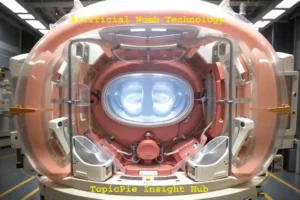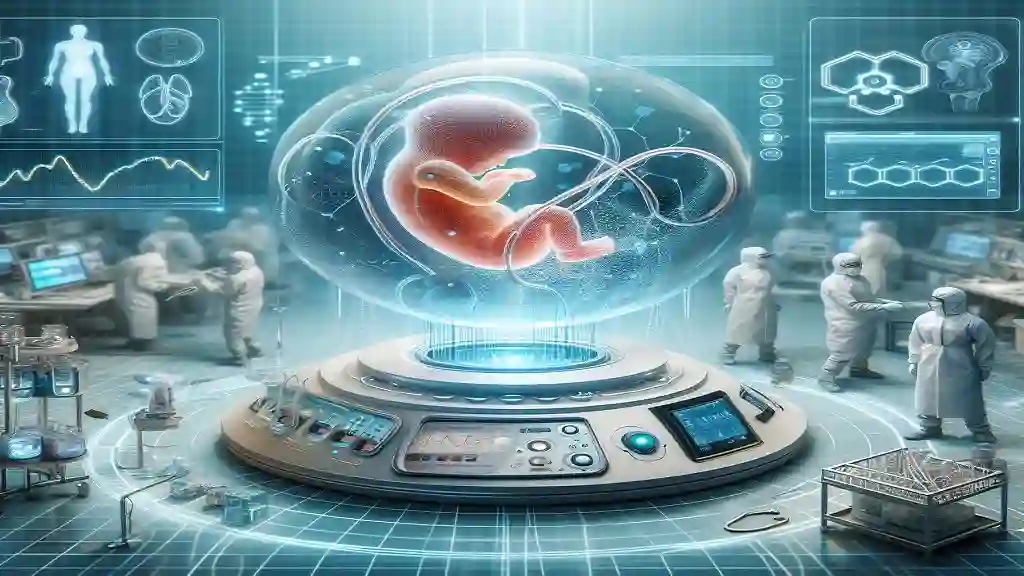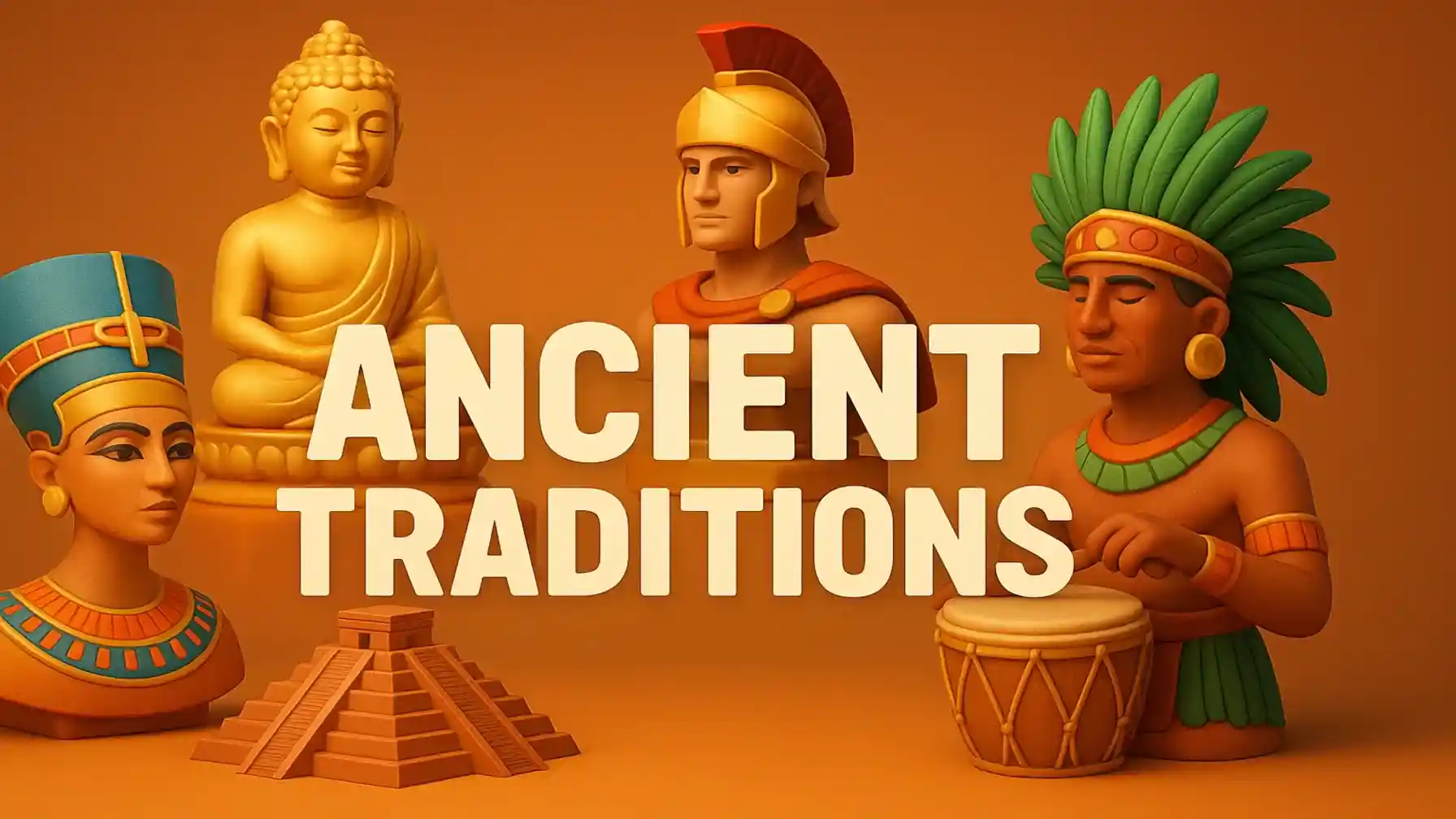Imagine a world where pregnancy is no longer limited to the confines of a woman’s body. A world where artificial wombs, with their revolutionary technology, redefine the very concept of motherhood and reproduction. This groundbreaking innovation has captured scientists’ and researchers’ worldwide imagination. They strive to create an environment nurturing life beyond traditional nature boundaries. In this blog post, we delve into the fascinating realm of artificial womb technology.
We’ll explore its components, discuss ongoing research and development efforts. We’ll ponder philosophical considerations and bioethics surrounding this breakthrough invention. Additionally, we’ll examine both its advantages and drawbacks. Join us on this captivating journey as we uncover how artificial wombs reshape our understanding of the miracle of life itself.
Key Elements of Artificial Womb Technology:
Artificial womb technology is revolutionizing the way we think about reproduction and motherhood. This groundbreaking innovation is made possible by a complex system of components that work together to create an environment where fetuses can develop outside the human body.
One crucial component of an artificial womb is its ability to provide nutrition, oxygen supply, and waste disposal. Just like in a natural pregnancy, the artificial womb must ensure that the growing fetus receives essential nutrients and oxygen while efficiently removing waste products.
The uterine wall plays a vital role in mimicking the natural environment of a uterus. It provides support for the developing fetus and helps maintain appropriate temperature and pressure levels.
Another key component is the interface or artificial placenta. This device acts as a bridge between the fetal circulatory system and external life-support systems, facilitating exchange between maternal blood flow and fetal circulation.
The amniotic tank, resembling an artificial amniotic sac, serves as a protective enclosure for the developing fetus. It contains fluid that mimics amniotic fluid found in natural pregnancies, providing cushioning and maintaining appropriate humidity levels.
An artificial umbilical cord connects the fetus to life-sustaining resources such as nutrient-rich fluids and oxygenated blood from external sources. The umbilical cord ensures proper nourishment and growth throughout gestation.
These components work seamlessly together to create an environment that closely resembles natural pregnancy conditions within an artificial setting. By simulating these critical elements essential for fetal development outside of a woman’s body, researchers are making incredible strides towards redefining what it means to be pregnant.
Optimizing Artificial Womb Technology: Nutrition, Oxygen Supply, and Waste Disposal Mechanisms Redefined for Fetal Development
Nutrition, oxygen supply, and waste disposal are vital components of an artificial womb. Just like in a natural pregnancy, the developing fetus needs nourishment to grow and thrive. In an artificial womb, this is achieved through a carefully balanced nutrient solution that provides all the essential vitamins, minerals, and proteins necessary for development.
But it’s not just about nutrition – oxygen supply is equally crucial. In the womb, the baby receives oxygen through the mother’s bloodstream. To replicate this process in an artificial environment, advanced technology ensures a constant flow of oxygen to support the growing fetus.
And let’s not forget about waste disposal! Like any living organism, a developing baby produces waste that needs to be eliminated efficiently. In an artificial womb, sophisticated mechanisms manage waste removal to maintain optimal conditions for fetal growth.
These three elements work together harmoniously within an artificial womb system – providing nourishment for healthy development while ensuring proper gas exchange and waste elimination. This intricate balance mimics nature as closely as possible and offers exciting possibilities for reproductive science.
The successful replication of these essential functions in an artificial womb brings us one step closer to redefining motherhood and revolutionizing reproduction methods.
Revolutionizing Reproduction: Unveiling the Artificial Womb’s Role in Uterine Wall Simulation
The uterine wall is a crucial component of the artificial womb, providing the necessary environment for the developing fetus. It mimics the natural uterus by creating a supportive and protective space for the embryo to grow.
One key aspect of the uterine wall is its ability to expand and contract, just like in a real pregnancy. This allows for optimal fetal development and movement. The walls are made from a flexible material that can stretch as the baby grows, ensuring comfort and safety.
In addition to providing structural support, the uterine wall also plays an important role in nutrient delivery. It contains tiny blood vessels that supply oxygen and essential nutrients to the developing fetus. These blood vessels are connected to an external system that monitors and adjusts nutrient levels as needed.
Furthermore, the uterine wall acts as a barrier against harmful substances or infections. It prevents toxins or pathogens from entering into contact with the developing fetus, thus ensuring its wellbeing.
By replicating the functions of a natural uterus, including expansion/contraction capabilities and nutrient delivery while providing protection against harmful substances, artificial wombs offer new possibilities for reproduction and redefine traditional notions of motherhood.
Artificial Womb Technology: Navigating the Interface of an Innovative Placenta Simulation for Fetal Development

The interface, also known as the artificial placenta, is a crucial component of the artificial womb technology. It serves as a connection between the developing fetus and the external environment. Just like in a natural pregnancy, this interface plays a vital role in facilitating nutrient and oxygen exchange.
The design of the artificial placenta mimics that of a real placenta, with intricate blood vessels and membranes to allow for efficient transfer of substances between mother and baby. It ensures that essential nutrients are delivered to the growing fetus while waste products are removed from its system.
Researchers tirelessly optimize the interface, exploring materials and structures mimicking a natural placenta. The goal is to create an environment within the artificial womb resembling a fetus’s experience inside its mother’s uterus.
By perfecting this aspect of artificial womb technology, scientists aim to provide an alternative for babies facing complications. They cannot thrive or survive outside the womb. The ability to replicate complex physiological processes opens new possibilities for reproductive medicine, potentially redefining motherhood.
However, ethical considerations surrounding this technology remain prominent. Questions arise regarding ownership rights over embryos developed in an artificial womb setting, potential misuse or exploitation of reproductive technologies, and how these advancements may impact societal notions about gender equality and LGBT parenting.
As research continues on developing more advanced interfaces for artificial wombs, it is important for society at large to engage in thoughtful discussions about these bioethical concerns. Only through open dialogue can we navigate towards responsible use and implementation of such groundbreaking technologies.
Amniotic tank (artificial amniotic sac)
The amniotic tank, also known as the artificial amniotic sac, is a crucial component of the artificial womb technology. It serves as a protective environment for the developing fetus, simulating the conditions inside a mother’s womb.
Within this amniotic tank, researchers have created a fluid-filled chamber that mimics the amniotic fluid found in natural pregnancies. This fluid provides cushioning and support to the growing fetus, allowing it to move and develop without constraints.
The composition of this artificial amniotic fluid is carefully formulated to provide essential nutrients and hormones necessary for fetal development. It closely replicates the complex mixture found in natural amniotic fluid, ensuring optimal growth and nourishment.
Furthermore, the temperature and pH levels within the amniotic tank are regulated to create an environment similar to that of a mother’s womb. This control over environmental factors allows researchers to closely monitor and optimize conditions for fetal development.
By creating an artificial amniotic sac, scientists aim to provide preterm babies with an extended period of gestation outside of their mothers’ bodies. This breakthrough technology holds significant potential in improving neonatal care and reducing complications associated with premature births.
However, further research is still needed to refine these technologies before widespread implementation can occur. Ethical considerations surrounding its use must also be carefully explored as we navigate this new frontier in reproductive science. The future possibilities offered by artificial wombs are truly awe-inspiring!
Umbilical cord
The umbilical cord plays a vital role in the development of a fetus within the womb. It serves as the lifeline, connecting the growing baby to its mother, providing essential nutrients and oxygen while removing waste products. This incredible structure is now being replicated in artificial womb technology.
In an artificial womb, scientists have ingeniously recreated the function of the umbilical cord through advanced medical engineering. The synthetic version acts as a conduit for delivering nutrients and oxygen directly to the developing fetus, mimicking nature’s own design.
This breakthrough opens new possibilities for gestating babies outside a traditional uterus. It also offers hope for premature infants who require extra support in their crucial early stages of development. By recreating this intricate system within an artificial environment, medical professionals can provide optimal care and nourishment to these vulnerable little ones.
The umbilical cord component of an artificial womb represents another remarkable achievement in reproductive science. It exemplifies our ongoing quest to redefine motherhood and revolutionize how we bring life into this world. With further advancements on the horizon, it’s awe-inspiring to imagine what lies ahead for this groundbreaking technology.
Research and Development of Artificial Womb Technology
Research and development in the field of artificial womb technology has been a topic of great interest and exploration for scientists and medical professionals around the world. Various institutions and researchers have embarked on groundbreaking projects to advance this revolutionary technology.
One such pioneer is Emanuel M. Greenberg from the United States, who conducted extensive research on creating an environment that closely mimics the natural womb. His work focused on developing a system that provides nutrition, oxygen supply, waste disposal, and hormonal regulation to support fetal development.
In Japan, Juntendo University has also made significant contributions to artificial womb research. Their team successfully created a device that resembles a uterus by using synthetic materials capable of maintaining stable conditions for embryonic growth.
The Children’s Hospital of Philadelphia is another prominent institution at the forefront of artificial womb technology. They have developed an interface known as an “artificial placenta” which allows for efficient exchange of oxygen and nutrients between the fetus and external systems.
Eindhoven University of Technology in the Netherlands has made strides in creating an artificial amniotic sac called an “amniotic tank.” This innovative device aims to provide optimal protection for premature infants during their crucial developmental stages outside the natural uterus.
Additionally, researchers at Weizmann Institute of Science in Israel are exploring methods to create functional umbilical cords outside the body through tissue engineering techniques. This breakthrough could potentially allow direct nutrient transfer from external sources directly into the fetus.
These remarkable advancements highlight how dedicated scientists worldwide are pushing boundaries in reproductive medicine with their innovative approaches towards developing artificial wombs. As further research progresses, we can anticipate even more significant breakthroughs that may redefine motherhood as we know it today.
Emanuel M. Greenberg (USA)
Emanuel M. Greenberg, a renowned scientist from the United States, has made significant contributions to the development of artificial womb technology. His groundbreaking research and innovative ideas have pushed the boundaries of reproductive science.
One area that Greenberg focused on was creating an interface between the artificial placenta and the fetus. This interface plays a crucial role in providing essential nutrients, oxygen supply, and waste disposal for proper fetal development. Through his studies, Greenberg has explored different materials and designs to ensure optimal functionality.
Another aspect of Greenberg’s work involves studying the uterine wall within an artificial womb. Understanding how this structure functions is key to replicating its environment accurately. By mimicking the conditions found in a natural uterus, scientists can create an ideal setting for fetal growth and development.
Greenberg’s research also delves into improving the design of the amniotic tank or artificial amniotic sac. This component is responsible for providing protection and maintaining a stable environment for the growing fetus. Greenberg’s advancements in this area have paved new paths for ensuring optimal conditions inside an artificial womb.
Additionally, one crucial element that Greenberg has worked on is developing an efficient umbilical cord system within an artificial womb setup. The umbilical cord serves as a lifeline between mother and fetus during pregnancy by supplying essential nutrients and removing waste products. Greenberg’s innovations aim to replicate this vital connection accurately.
Emanuel M. Greenberg’s pioneering work in artificial womb technology has opened up new possibilities in redefining motherhood and reproduction. His dedication to advancing scientific knowledge brings us closer to realizing safer alternatives for gestation outside of traditional methods—a remarkable contribution shaping our understanding of human life creation.
Juntendo University (Japan)
Juntendo University in Japan is at the forefront of research and development in the field of artificial womb technology. With a team of dedicated scientists and medical professionals, they are actively working towards creating an artificial womb that can support the growth and development of premature babies.
At Juntendo University, their focus is on developing an interface that mimics the function of a natural placenta. This interface will play a critical role in providing nutrition, oxygen supply, and waste disposal for the growing fetus within the artificial womb.
The researchers at Juntendo University are also exploring ways to enhance the uterine wall component of their artificial womb. By recreating the ideal conditions found in a mother’s uterus, they hope to optimize fetal development and ensure better outcomes for premature infants.
Another key area of study at Juntendo University is improving upon existing amniotic tanks used in artificial wombs. The goal is to create an environment that closely resembles the amniotic sac where a baby would typically grow during pregnancy.
Additionally, Juntendo University is researching innovative methods for creating synthetic umbilical cords that can effectively deliver nutrients and remove waste products from the fetus.
Through their groundbreaking work, Juntendo University is pushing boundaries and challenging traditional notions surrounding reproduction and motherhood. Their dedication to advancing this technology has immense potential to revolutionize neonatal care and offer new possibilities for families around the world.
Disclaimer: The information provided here may not be accurate or current as research on Artificial Womb Technology is ongoing with advancements happening rapidly. Please consult trusted sources or experts for up-to-date information.
Children’s Hospital of Philadelphia
Children’s Hospital of Philadelphia (CHOP) is at the forefront of research and development when it comes to artificial womb technology. With a dedicated team of scientists and medical professionals, CHOP is pushing boundaries in reproductive medicine. Their goal? To create an environment where premature babies can continue to grow and develop outside the mother’s womb.
At CHOP, researchers are focused on perfecting the components of an artificial womb. They understand the importance of providing proper nutrition, oxygen supply, and waste disposal for these delicate infants. By mimicking the functions of a natural uterus, they aim to give premature babies a fighting chance at life.
One key area of focus for CHOP is creating an interface that acts as an artificial placenta. This component plays a critical role in supplying oxygen to the baby while removing carbon dioxide from their system. With advancements in technology, scientists at CHOP are making great strides in achieving this feat.
Another crucial element being explored by CHOP is the development of an artificial amniotic sac or “amniotic tank.” This structure would provide protection and cushioning for the baby during its time in the artificial womb. It aims to replicate the nurturing environment that a natural amniotic sac offers.
Researchers at CHOP also recognize the significance of designing an effective umbilical cord replacement within their artificial womb model. This lifeline will be responsible for delivering vital nutrients and blood flow to support healthy growth and development.
The work being done at Children’s Hospital of Philadelphia holds immense promise for improving neonatal care and redefining motherhood as we know it. While there are still challenges ahead before widespread adoption can occur, their dedication to advancing this groundbreaking technology represents hope for countless families around the world.

Eindhoven University of Technology (NL)
Eindhoven University of Technology (TU/e) in the Netherlands is at the forefront of artificial womb research, pushing boundaries and exploring new possibilities. The dedicated team of scientists and researchers at TU/e are driven by a shared vision – to redefine motherhood and revolutionize reproduction.
One area that sets TU/e apart is their focus on developing an advanced interface for artificial wombs, known as the artificial placenta. This crucial component aims to mimic the functions of a natural placenta, ensuring proper nutrient delivery and waste removal for the growing fetus. Through innovative engineering techniques, TU/e’s researchers are making significant strides in creating a functional and efficient artificial placental system.
Another key aspect of their work involves enhancing the uterine wall of artificial wombs. By studying various materials and structures, they strive to create an environment that closely resembles a natural uterus while providing optimal support for fetal development.
Also Read: Kia Sonet facelift VS old Kia Sonet | What’s New in Sonet Facelift? Kia Sonet 2023 2024 launched
Furthermore, TU/e’s expertise extends to perfecting the amniotic tank within an artificial womb. This specialized container replicates the amniotic sac found in pregnant women, maintaining fluid levels and offering protection to the developing fetus.
The interdisciplinary approach taken by Eindhoven University allows them to collaborate with experts from diverse fields such as bioengineering, obstetrics, and neonatology. This collaboration enhances their research capabilities and ensures comprehensive understanding across different aspects involved in developing successful artificial womb technology.
Through their relentless pursuit of knowledge coupled with cutting-edge technological advancements, TU/e continues to push boundaries in this field. With each breakthrough they achieve, they bring us closer to a future where reproductive possibilities are expanded beyond traditional means.
By redefining motherhood through their pioneering work, Eindhoven University is shaping a world where infertility may no longer be an insurmountable barrier, and reproductive choices can be broadened for individuals around the globe.
Their commitment inspires confidence that one day soon we may witness the realization of fully functional artificial wombs – truly groundbreaking technology that will forever change the landscape of human reproduction.
Weizmann Institute of Science (Israel)
The Weizmann Institute of Science, located in Israel, is at the forefront of research and development in various scientific fields. When it comes to artificial womb technology, the institute has made significant contributions and advancements.
Researchers at the Weizmann Institute are exploring ways to create an artificial environment that can support fetal development outside the mother’s body. By studying reproductive biology and embryology, they aim to design a system that mimics the conditions inside a natural womb.
One area of focus for the scientists at Weizmann is creating an artificial placenta that can provide oxygen and nutrients to the developing fetus. This component is crucial for ensuring proper growth and development.
Additionally, they are investigating methods for waste disposal within this simulated womb environment. Efficient removal of waste products is essential to maintain a healthy environment for fetal growth.
The researchers at Weizmann are also studying how to regulate temperature and hormonal balance within their artificial womb prototype. These factors play vital roles in supporting optimal fetal development.
By collaborating with experts from different disciplines such as engineering, biology, and medicine, scientists at the Weizmann Institute are pushing boundaries in understanding reproduction and motherhood on a whole new level.
Their groundbreaking work holds promise not only for improving outcomes for premature babies but also potentially redefining traditional notions of conception and pregnancy. The future implications of their research could revolutionize our understanding of human reproduction as we know it!
Exploring Artificial Womb Technology: Philosophical Considerations and Bioethics
When discussing artificial womb technology, it is crucial to delve into the philosophical considerations and bioethical implications that this groundbreaking innovation brings. One of the key aspects to ponder is how this technology can redefine traditional notions of motherhood and reproduction.
Gender equality and LGBT rights are central themes in these discussions. Artificial wombs have the potential to eliminate gender-based inequalities in childbirth, as individuals could have equal opportunities to experience biological parenthood. This advancement could also provide a solution for same-sex couples who wish to conceive genetically related children without relying on surrogacy or adoption.
Furthermore, bioethics play a significant role in shaping our approach towards artificial womb technology. Questions arise regarding the moral status of embryos developed outside a human body, as well as concerns about premature births resulting from potentially earlier removals from an artificial womb compared to natural gestation.
Additionally, there are ethical considerations surrounding access and affordability. Will this technology be available only for those with financial means? How will it impact society at large?
These philosophical deliberations call for careful examination and open dialogue among scholars, policymakers, medical professionals, ethicists, religious leaders, and individuals alike. As society grapples with these complex questions pertaining to personhood, autonomy, reproductive ethics, social dynamics – we must strive for a balanced perspective that values scientific progress while upholding fundamental human rights and dignity.
Ultimately, the development of artificial womb technology has the potential to revolutionize reproductive technologies and redefine our understanding of parenthood. As with any groundbreaking innovation, it is crucial to carefully consider the philosophical and bioethical implications and ensure that its implementation aligns with ethical principles and values.
Gender equality and LGBT (Lesbian, Gay, Bisexual and Transgender)
Gender equality and LGBT rights are crucial considerations when discussing artificial womb technology. In traditional reproductive methods, women have often borne the burden of carrying a pregnancy and experiencing the physical and emotional toll that comes with it. Artificial wombs have the potential to shift this dynamic by providing an alternative method for gestation.
One of the key advantages is that artificial womb technology could allow individuals who do not possess a uterus or who identify as male to experience pregnancy and childbirth. This has significant implications for gender equality, as it challenges societal expectations around reproduction and parenting roles.
Additionally, artificial wombs may also offer options for same-sex couples or individuals in the LGBTQ+ community who wish to have biological children together. By removing the need for a traditional human womb, these technologies open up new possibilities for family building.
However, it’s important to approach these advancements with caution and consider the ethical implications they may raise. Questions about parental rights, legal frameworks, and social acceptance must be addressed to ensure that all individuals regardless of their gender identity or sexual orientation can access these reproductive technologies equitably.
As we continue to explore artificial womb technology, inclusivity should remain at the forefront of discussions. It is essential that we create a future where everyone has equal opportunities to become parents if they choose so – regardless of their gender or sexual orientation.
The World’s First Artificial Womb
In a groundbreaking development, researchers have successfully created the world’s first artificial womb. This revolutionary technology has the potential to redefine motherhood and revolutionize reproduction as we know it.
The artificial womb, also known as an ectogenesis chamber, simulates the conditions of a natural womb and provides an optimal environment for fetal development. It is designed to support the growth and maturation of embryos outside of a human body.
This remarkable achievement brings hope to couples struggling with infertility or medical complications that make pregnancy difficult or impossible. It offers a viable alternative for those who cannot conceive naturally or carry a pregnancy to term.
The concept of an artificial womb raises numerous ethical considerations and societal implications. While it promises immense benefits, such as increased reproductive options and gender equality, there are concerns about the commodification of reproduction and the potential devaluation of traditional motherhood.
Despite these controversies, the development of this technology marks an incredible milestone in scientific progress. As research continues in this field, we can expect further advancements that will shape our understanding of reproduction and redefine our notions of parenthood.
It is important to note that while significant progress has been made in creating an artificial womb, practical implementation on a widespread scale may still be years away. However, this breakthrough serves as a testament to human ingenuity and opens up new possibilities for individuals longing for parenthood.
As scientists continue their pursuit in perfecting this technology, it is crucial that ethical guidelines are established to ensure its responsible use. The future holds great promise for artificial wombs – ushering in a new era where conception knows no bounds.
The Concept of Artificial Womb Technology:
The concept of artificial womb technology has the potential to revolutionize reproduction and redefine our understanding of motherhood. It presents a groundbreaking solution for women who are unable to carry a pregnancy due to medical reasons or personal circumstances.
Imagine a world where embryos can be nurtured and developed outside the human body, in an artificial womb. This technology could provide hope and options for couples struggling with infertility or individuals who have always dreamed of becoming parents but never thought it was possible.
By creating an environment that mimics the conditions inside the uterus, scientists are working towards developing artificial wombs that can support embryonic growth from conception to birth. This would involve replicating key components such as nutrition supply, oxygenation, waste disposal, and even simulating contractions experienced during natural childbirth.
While this may sound like something out of science fiction, researchers around the world are actively exploring this possibility. Institutions such as Emanuel M. Greenberg in the USA, Juntendo University in Japan, Children’s Hospital of Philadelphia, Eindhoven University of Technology in NL and Weizmann Institute of Science in Israel have made significant strides in advancing artificial womb technology.
The implications and ethical considerations surrounding this technology are vast. Questions regarding gender equality and LGBT rights arise when discussing alternative methods for gestation outside traditional biological norms. Additionally, concerns about premature births being artificially prolonged through extended use of an artificial womb raise important debates within bioethics.
The journey towards realizing fully functional artificial wombs is ongoing but promising advancements continue to emerge. The future holds great potential for transforming reproductive possibilities by redefining what it means to carry a child.
The Pros and Cons of Artificial Womb Technology:
Artificial womb technology has the potential to revolutionize reproduction and redefine motherhood. However, like any groundbreaking invention, it comes with its own set of pros and cons.
On the positive side, artificial wombs can offer hope to couples struggling with infertility or medical conditions that make traditional pregnancy impossible. It could eliminate many of the risks associated with pregnancy, such as preterm birth and complications for both the mother and the baby. Additionally, artificial wombs may provide a solution for same-sex couples or individuals who want to experience biological parenthood.
Another advantage is that this technology could allow babies born prematurely to continue their development outside of the mother’s body in a controlled environment. This could significantly increase their chances of survival and reduce long-term health issues associated with premature birth.
However, there are ethical concerns surrounding artificial womb technology. Some argue that it diminishes the natural bond between a mother and her child by removing the need for gestation in her body. There are also questions about how society would view children born through this method – will they be perceived as less “natural” than those conceived naturally?
Additionally, there may be potential risks involved in transferring embryos from an IVF procedure into an artificial womb. The success rates and safety of these procedures would need thorough examination before widespread adoption.
Furthermore, there are economic considerations to take into account. The development and implementation of artificial womb technology would come at a significant cost which might limit accessibility for certain populations.
While artificial womb technology holds great promise for overcoming reproductive challenges, it is essential to carefully consider both its advantages and disadvantages before embracing it fully into our society.
Dr. Nicola Williams
Dr. Nicola Williams is a pioneering figure in the field of artificial womb technology. With her groundbreaking research and innovative approach, she has brought us one step closer to redefining motherhood and reproduction.
As a leading expert in the field, Dr. Williams has dedicated her career to exploring the possibilities of artificial wombs. Her work focuses on developing advanced technologies that mimic the natural environment of the womb, allowing for the growth and development of embryos outside of the human body.
Through her research, Dr. Williams aims to address various challenges associated with traditional methods of reproduction, such as infertility and pregnancy complications. By creating an artificial womb that can provide optimal conditions for fetal development, she envisions a future where all individuals have equal access to safe and effective reproductive options.
Dr. Williams’ contributions are not limited to scientific advancements alone; she also actively advocates for gender equality and LGBT rights within the context of reproductive technologies. She believes that everyone should have the opportunity to experience parenthood regardless of their biological capabilities or sexual orientation.
In addition to her remarkable achievements in academia, Dr. Nicola Williams is also a sought-after speaker at international conferences and symposiums on reproductive medicine and bioethics. Her passion for spreading knowledge about artificial womb technology has inspired countless researchers and medical professionals around the world.
With each new discovery made by Dr. Williams and her team, we edge closer towards realizing a future where conception no longer relies solely on traditional means but embraces cutting-edge science instead.
Implementing Firefly liquid handling for the development of laboratory tests
Utilizing firefly liquid handling technology has revolutionized laboratory developed tests (LDTs) in recent years. This cutting-edge method allows for precise and efficient handling of liquids, significantly improving the accuracy and reliability of test results.
Gone are the days of manual pipetting, which often resulted in human error and variability. With firefly liquid handling, laboratories can now automate the entire process. It covers sample preparation to analysis, ensuring consistent and reproducible outcomes. This innovative technology transforms laboratory workflows significantly.
The advanced robotics system in firefly liquid handling comes with state-of-the-art sensors. These sensors detect minute liquid volumes with unparalleled precision, reducing wastage and minimizing contamination risks. It’s ideal for sensitive assays like molecular diagnostics or drug discovery research.
Furthermore, the intuitive software interface enables scientists to easily program complex protocols and customize workflows based on specific experimental requirements. This flexibility allows for faster turnaround times and increased throughput without compromising data quality.
In addition to its technical advantages, firefly liquid handling offers cost savings by reducing labor-intensive processes and increasing productivity. Laboratories can allocate their resources more efficiently while maintaining high standards in testing accuracy.
Utilizing firefly liquid handling technology in laboratory developed tests represents a significant leap forward in scientific research and diagnostic capabilities. Its ability to streamline workflows, improve data integrity, and enhance efficiency makes it an invaluable tool for advancing scientific discoveries across various fields.
Immunopeptidomics offer new hope in Cancer Research
Immunopeptidomics, a cutting-edge field in cancer research, is offering new hope in the fight against this devastating disease. By studying the unique peptides presented on the surface of cancer cells, scientists are gaining valuable insights into tumor biology and developing innovative therapeutic approaches.
One of the key advantages of immunopeptidomics is its ability to identify tumor-specific antigens that can be targeted by the immune system. These antigens serve as “flags” to alert immune cells to attack and destroy cancerous cells. By analyzing the repertoire of peptides displayed by tumors, researchers can uncover novel targets for immunotherapy drugs.
Furthermore, immunopeptidomics has enabled a deeper understanding of how tumors evade immune surveillance. Cancer cells employ various mechanisms to suppress or escape immune recognition, hindering effective treatment strategies. With immunopeptidomic analysis, scientists can decipher these evasion tactics and devise countermeasures to enhance immune responses against tumors.
Moreover, recent advancements in mass spectrometry and computational analysis have revolutionized immunopeptidomics research. These technologies allow for high-throughput screening of peptide profiles from patient samples, enabling personalized cancer treatments tailored to individual antigen repertoires.
Immunopeptidomics holds immense promise for improving cancer diagnosis and therapy. Its ability to unravel tumor-specific antigens and decode immune evasion mechanisms opens up exciting avenues for developing targeted therapies that could significantly impact patient outcomes.
Examining Bottlenecks in Nucleic Acid Extraction through a Multi-Industrial Perspective
When it comes to nucleic acid extraction, researchers and scientists are constantly faced with challenges that can hinder the process. These bottlenecks require innovative solutions for a more efficient and streamlined approach. One such solution is a multi-industrial approach, which brings together expertise from various fields to tackle these obstacles head-on.
In the world of genomics and molecular biology, nucleic acid extraction plays a crucial role in obtaining high-quality DNA or RNA samples for further analysis. However, traditional extraction methods often suffer from limitations such as low yield, contamination issues, and time-consuming protocols.
To overcome these bottlenecks, a multi-industrial approach combines knowledge and technologies from different industries. For example, advancements in microfluidics have paved the way for miniaturized devices that can automate and accelerate the extraction process. By integrating robotics and automation into the workflow, researchers can achieve higher throughput while reducing human error.
Also Read: The Pros and Cons of Veto Power: Unveiling Its Implications
Additionally, collaborations with experts in materials science have led to the development of novel nanomaterials specifically designed for efficient nucleic acid capture. These materials offer improved binding affinity and selectivity, resulting in higher yields of pure DNA or RNA samples.
Another bottleneck addressed through a multi-industrial approach is scalability. With increasing demands for genetic testing and personalized medicine applications, the development of extraction methods becomes crucial. These methods should handle large sample volumes without sacrificing quality or efficiency. By leveraging expertise from industries specializing in manufacturing processes and logistics management, scalable solutions can be devised. These solutions aim to meet the growing demands for genetic testing and personalized medicine applications.
Furthermore, interdisciplinary collaborations enable the integration of cutting-edge technologies like artificial intelligence (AI) into nucleic acid extraction workflows. AI algorithms can optimize parameters such as reagent concentrations, incubation times, and temperature profiles based on real-time data feedback – leading to faster processing times and increased efficiency.
Adopting a multi-industrial approach holds great promise in overcoming bottlenecks associated with nucleic acid extraction.
Through collaboration across disciplines—microfluidics, materials science, robotics, and AI—researchers can revolutionize workflows. They address current challenges in this critical process, improving efficiency, speed, and downstream applications in genomics, diagnostics, and personalized medicine.
FDA Examines the Use of Artificial Wombs in Improving Preemie Baby Survival: Key Insights into the Emerging Technology
The FDA’s recent discussion focuses on using artificial wombs to save preemie babies. This has sparked excitement and curiosity in the medical community. This groundbreaking technology could revolutionize premature infant care, increasing their chance at survival and healthy development.
Artificial wombs, or ectogenesis, seek to replicate the conditions of a natural womb outside the mother’s body. These devices provide optimal nutrition, oxygen supply, and waste disposal. They offer hope for premature infants who struggle to thrive in traditional incubators.
One of the key advantages of artificial wombs is their potential to minimize complications associated with premature birth. Premature babies often face respiratory difficulties due to underdeveloped lungs. With an artificial womb providing continuous oxygenation, these challenges could be mitigated.
Additionally, this technology opens up possibilities for earlier intervention and treatment options. Preemies can receive specialized care tailored specifically to their needs while still inside the artificial womb. This allows healthcare providers more time to monitor and address potential health issues. It occurs before transitioning infants into traditional neonatal intensive care units (NICUs).
While there are still many ethical considerations surrounding this technology—such as questions about gestational limits or parental rights—it undeniably holds promise for improving outcomes for preterm infants.
As research continues and regulatory bodies like the FDA (U.S. Food and Drug Administration) explore its potential applications further, we may soon see artificial wombs becoming a vital tool in neonatology departments worldwide. The future looks bright for saving precious little lives through this revolutionary innovation!
Adorable ‘Mayor of NICU’ Baby Celebrates Early Hospital Release Before Turning One
In a heartwarming and inspiring story, a baby who earned the nickname “mayor of NICU” has been released from the hospital just in time for their first birthday. This little fighter spent months in the Neonatal Intensive Care Unit (NICU), battling through medical challenges with unwavering strength.
The journey was undoubtedly tough, but this tiny warrior showed incredible resilience from day one. Surrounded by a dedicated team of doctors and nurses, they received round-the-clock care and support. Every milestone achieved – every breath taken independently; every ounce gained – was celebrated as a triumph.
The parents of this remarkable child faced an emotional rollercoaster during their time in the NICU. They witnessed firsthand how love can overcome even the most difficult circumstances. Their unwavering devotion to their little one never wavered, providing comfort and stability amidst uncertainty.
Now, as this brave baby heads home with their family, there is no doubt that they will continue to inspire those around them. Their story serves as a reminder that miracles do happen, and that hope should never be underestimated.
Congratulations to the “mayor of NICU” on reaching this incredible milestone! May your future be filled with boundless joy, good health, and endless possibilities.
Newborn Rescued by First Responders at 25 Weeks Finds Lifesavers Named as Godparents
In a heartwarming turn of events, a group of first responders has been named the godparents of a newborn baby whose life they saved at just 25 weeks’ gestation. This incredible story beautifully highlights the immense impact that these everyday heroes can have on people’s lives.
It all started when the mother unexpectedly went into premature labor and gave birth to her tiny baby girl. The first responders quickly arrived on the scene and sprang into action, providing immediate medical care to stabilize the fragile infant. Their quick thinking and expertise undoubtedly played a crucial role in saving this precious life.
As time passed, it became clear that this special bond between the first responders and the baby was something extraordinary. The parents recognized their unwavering dedication and selflessness, deciding to honor them by asking them to become godparents.
This unique arrangement emphasizes the deep gratitude felt by the child’s family. It serves as a powerful reminder of how interconnected our lives can be. Through acts of kindness and heroism like this, humanity’s capacity for compassion and love is vividly showcased.
The story serves as an inspiration for us all, reminding us to cherish those who go above and beyond in their duty to protect others. These brave individuals touch our lives in profound ways, often without even realizing it themselves.
Let us celebrate these remarkable first responders turned godparents who embody what it means to be true heroes. Their actions have forever changed the trajectory of this little one’s life, leaving an indelible mark on both her future and theirs.
How strong does a baby kick in the womb?: New study finds its powerful
Did you ever wonder how strong a baby’s kick can be in the womb? Well, a recent study has found that those tiny little kicks pack some serious power! According to researchers, babies can deliver quite the punch while still nestled snugly inside their mother’s belly.
The study used advanced imaging techniques to capture the movements of unborn babies. It revealed that not only do babies kick with force, but they also have remarkable coordination and precision. It’s incredible to think about these little beings flexing their muscles and honing their motor skills before even entering the world.
Experts believe that these powerful kicks serve an important purpose. They help strengthen the baby’s muscles and bones, preparing them for life outside the womb. Additionally, kicking allows babies to explore their surroundings and interact with their environment in utero.
As parents-to-be, it’s fascinating to learn about these amazing capabilities of our unborn children. It reminds us of just how miraculous and awe-inspiring pregnancy truly is. So next time you feel your baby kicking inside you, take a moment to appreciate the strength and determination they possess even before birth.
Remember though, every pregnancy is unique, so don’t worry if your little one isn’t delivering karate-style kicks just yet. As long as you’re feeling regular movement patterns throughout your pregnancy, it’s a good sign that everything is progressing well.
This new study sheds light on just how powerful those tiny kicks can be in the womb. It highlights another incredible aspect of human development and adds to our understanding of prenatal life.
Conclusion:
In our rapidly advancing technological landscape, the idea of an artificial womb is revolutionizing concepts of motherhood and reproduction. Ongoing research strives to create a conducive environment for gestating embryos outside the human body. This brings us one step closer to the groundbreaking possibility of artificial gestation. Developing a viable environment for gestating embryos is a key focus of current research. This advancement holds the potential to revolutionize the field, bringing us closer to this groundbreaking possibility. Scientists are on the verge of creating an alternative to traditional gestation, reshaping our understanding of reproductive processes.
The components of an artificial womb include nutrition supply, oxygenation, and waste disposal. It also features a uterine wall simulation and an interface resembling the placenta. Additionally, there’s an amniotic tank that mimics the amniotic sac and an umbilical cord-like connection for optimal functionality. These intricate systems work together to provide everything needed for fetal development.
Researchers all around the globe are actively contributing to the progress in artificial womb technology. Emanuel M. Greenberg in the USA has made significant strides in developing a functional model. Juntendo University in Japan is also at the forefront with their efforts towards creating a fully functioning artificial uterus.
Also Read: Why Choose India as Your Ultimate Destination Wedding Location?
Bioethics and philosophical considerations come into play when discussing this groundbreaking technology. Artificial wombs have potential implications for gender equality as they may offer alternative methods of reproduction beyond traditional means. The LGBT community could potentially benefit from these advancements as well.
In 2017, researchers at Children’s Hospital of Philadelphia reported the world’s first successful use of an artificial womb. They nurtured premature lambs in fluid-filled bags, replicating conditions within natural uteri. This breakthrough opened up new possibilities for saving preemie babies’ lives.
Artificial womb technology brings both benefits and drawbacks to consider. On one hand, it offers hope for those struggling with infertility or high-risk pregnancies. It provides a safe haven for fetal growth outside the maternal body. Dr. Nicola Williams is fueled by her passion for reproductive medicine and assisted reproductive technologies (ARTs). She firmly believes that artificial wombs have the potential to revolutionize global reproductive healthcare practices.
Concerns about ethical dilemmas arise. Issues include parental rights and potential misuse of technology leading to “designer babies.” It is crucial to navigate these challenges carefully and ensure that the benefits outweigh the potential risks.
Currently, artificial wombs are still in their early stages of development and have yet to be tested on humans. With technological advancements and ongoing research, there is a possibility of witnessing the birth of the first human baby. This baby could be gestated entirely outside the maternal body, marking a significant milestone in reproductive science.
The concept may seem like science fiction, yet its potential impact on society is genuine. Only time will unveil the full potential of artificial womb technology. However, it is undeniably an exciting and thought-provoking development in reproductive healthcare.








